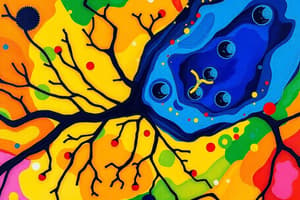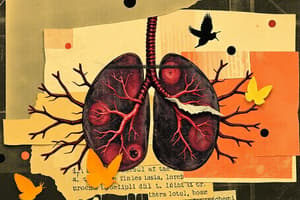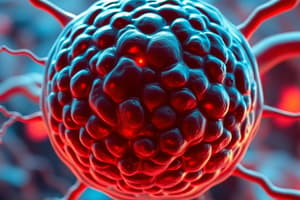Podcast
Questions and Answers
What is the primary energy currency of cells?
What is the primary energy currency of cells?
- Adenosine diphosphate (ADP)
- Adenosine monophosphate (AMP)
- Guanosine triphosphate (GTP)
- Adenosine triphosphate (ATP) (correct)
Which organelle plays a crucial role in the production of ATP?
Which organelle plays a crucial role in the production of ATP?
- Mitochondria (correct)
- Lysosome
- Endoplasmic reticulum
- Golgi apparatus
What is the first stage of cellular respiration?
What is the first stage of cellular respiration?
- Citric Acid Cycle
- Electron Transport Chain
- Glycolysis (correct)
- Oxidative Phosphorylation
Which compound is NOT generated during the Citric Acid Cycle?
Which compound is NOT generated during the Citric Acid Cycle?
What is the main function of the electron transport chain (ETC) in oxidative phosphorylation?
What is the main function of the electron transport chain (ETC) in oxidative phosphorylation?
Which type of DNA is maternally inherited and encodes proteins involved in the citric acid cycle and ATP synthesis?
Which type of DNA is maternally inherited and encodes proteins involved in the citric acid cycle and ATP synthesis?
How do mutations in mitochondrial DNA (mtDNA) or proteins affect cellular function?
How do mutations in mitochondrial DNA (mtDNA) or proteins affect cellular function?
Which organelle is responsible for synthesizing some of its own proteins and contains ribosomes?
Which organelle is responsible for synthesizing some of its own proteins and contains ribosomes?
What aspect of mitochondrial structure facilitates efficient ATP production?
What aspect of mitochondrial structure facilitates efficient ATP production?
How does the membrane potential generated by the proton gradient contribute to ATP synthesis?
How does the membrane potential generated by the proton gradient contribute to ATP synthesis?
Flashcards are hidden until you start studying
Study Notes
The Powerhouse: Mitochondria and Cellular Respiration
Mitochondria, the dynamic organelles within eukaryotic cells, play a crucial role in the production of adenosine triphosphate (ATP), our cells' primary energy currency. This article explores mitochondria's structure, function, and their central role in cellular respiration.
Mitochondrial Structure and Function
Mitochondria have two membranes: an outer membrane and an inner membrane. The outer membrane contains porins, large channels that facilitate the passage of small molecules and ions. The inner membrane is highly folded into structures called cristae, which greatly increase the surface area and help in efficient energy production. The intermembrane space and the inner matrix are two distinct compartments within the mitochondria.
Cellular Respiration: ATP Production
Cellular respiration is a series of metabolic processes that convert the chemical energy in nutrients into ATP. There are three stages to cellular respiration: glycolysis, the citric acid cycle (also called the Krebs cycle or TCA cycle), and oxidative phosphorylation.
- Glycolysis: Glucose is converted into pyruvate, which releases a small amount of ATP.
- Citric Acid Cycle: During this stage, pyruvate is imported into the mitochondria and oxidized to create a high-energy electron carrier called NADH and a compound called FADH2. The citric acid cycle also generates GTP (guanosine triphosphate) and ATP (from substrate-level phosphorylation).
- Oxidative Phosphorylation: NADH and FADH2 donate their electrons to the electron transport chain (ETC) embedded in the inner mitochondrial membrane. The ETC uses these electrons to pump protons across the inner membrane, creating a proton gradient and generating a membrane potential. This membrane potential drives ATP synthesis via a protein complex called ATP synthase.
Mitochondrial DNA and Genome
Mitochondria have their own DNA, called mtDNA. Mitochondrial DNA is maternally inherited and encodes essential proteins, such as those involved in the citric acid cycle and ATP synthesis. Mitochondria also have ribosomes and synthesize some of their own proteins, but most mitochondrial proteins are encoded by the cell's nuclear DNA and transported into the mitochondria.
Mitochondria and Human Disease
Mitochondrial dysfunction has been linked to various human diseases and disorders, such as Leigh syndrome and Alzheimer's disease. For example, mutations in mitochondrial DNA or proteins can impair the electron transport chain or ATP synthesis, leading to energy deficiencies and cellular dysfunction.
Conclusion
Mitochondria are critical for energy production in eukaryotic cells, and their central role in cellular respiration makes them essential for life. Their unique structure, with its two membranes and specialized compartments, facilitates efficient ATP production. Mitochondria's involvement in human disease demonstrates the importance of understanding the intricate processes and relationships between mitochondria and cellular function.
Studying That Suits You
Use AI to generate personalized quizzes and flashcards to suit your learning preferences.




